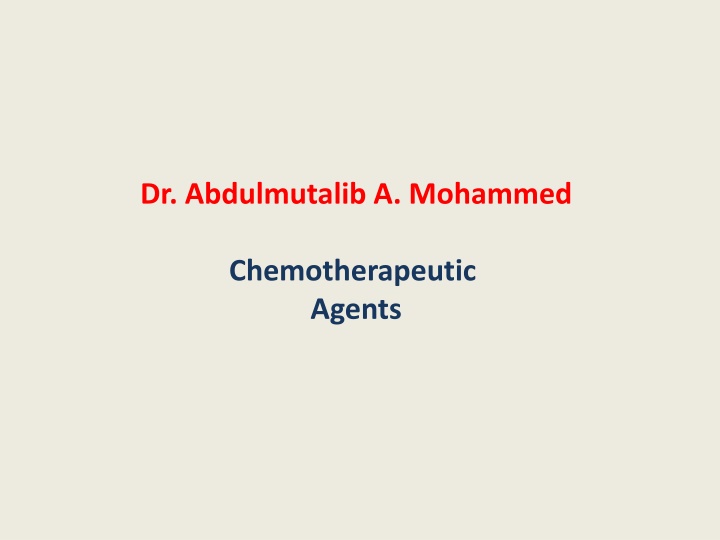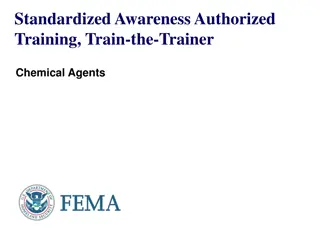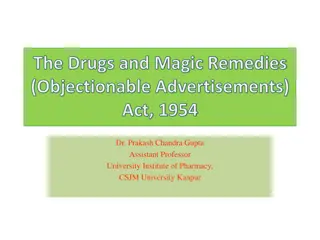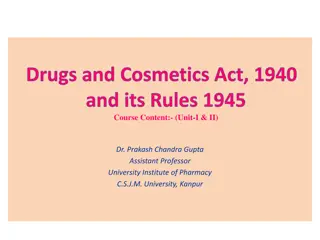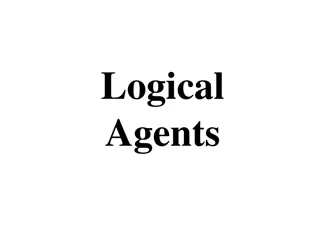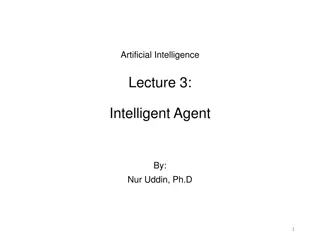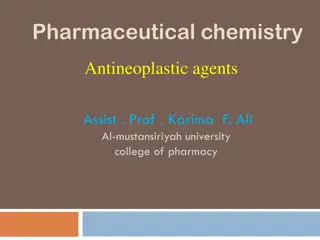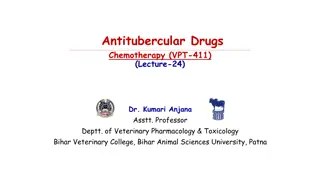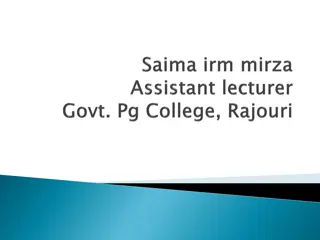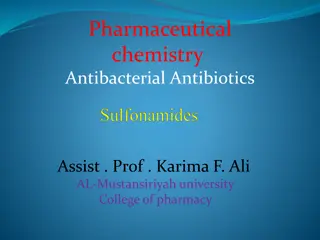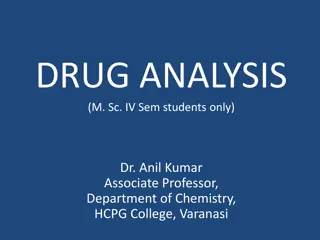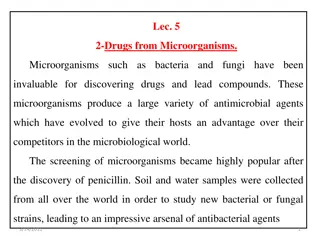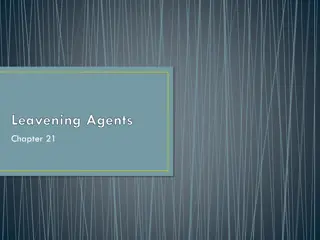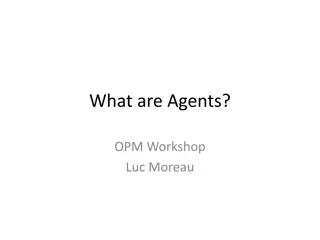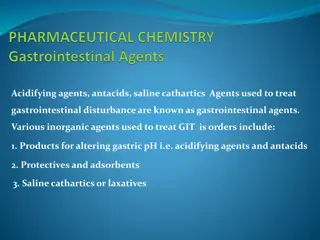Chemotherapeutic Agents and Antibacterial Drugs
Chemotherapeutic agents target microbes with minimal harmful effects on tissues. Antibacterial drugs are classified based on their action against bacteria. Learn about their mode and site of action.
Download Presentation

Please find below an Image/Link to download the presentation.
The content on the website is provided AS IS for your information and personal use only. It may not be sold, licensed, or shared on other websites without obtaining consent from the author.If you encounter any issues during the download, it is possible that the publisher has removed the file from their server.
You are allowed to download the files provided on this website for personal or commercial use, subject to the condition that they are used lawfully. All files are the property of their respective owners.
The content on the website is provided AS IS for your information and personal use only. It may not be sold, licensed, or shared on other websites without obtaining consent from the author.
E N D
Presentation Transcript
Dr. Abdulmutalib A. Mohammed Chemotherapeutic Agents
Chemotherapeutic Agents These are the agents which have lethal or inhibitory effect on the microbes , but in therapeutic concentration have little or no toxic action on the tissues . These agents used in chemotherapy are chemical compounds with low molecular weight and very diverse chemical structure . They can be divided into two categories : a- Relatively simple compounds obtained by chemical laboratory synthesis , e.g. sulfonamides , trimethoprim , etc. b- Antibiotics are the substances produced by living organisms and which are active , in small amounts , against other living organisms . Most of them are produced by soil Actinomycetes , specially the genus Streptomyces , as well as other bacteria , like Bacillus and Peudomonas , fungi , like the genus Penicillium with little antibiotics produce by plant and algae . Therefore , the term antimicrobial or antibacterial agent is used for both natural antibiotics and synthetic chemical agents .
Antibacterial agents are divided into two classes on the basis of type of action they exhibit against bacteria : 1- Bacteriostatic drugs : are drugs which , in the concentration attainable in the body , only inhibit bacterial growth ,e.g. Chloramphenicol , sulfonamides , tetracycline , etc. 2- Bacteriocidal drugs : are the drugs which kill the bacteria by virtue of their rapid lethal action , e.g. penicillins , cephalosporins , aminoglycosides , fucidin , nalidixic acid , etc. Bacteriocidal drugs are more effective therapeutic agents than bacteriostatic drugs .
Mode of Action The problem can be considered from two aspects : 1- identification of site of action of drug . 2- Its precise mechanism of action .
* Site of Action There are four major loci of action . 1- Inhibition of synthesis of cell wall peptidoglycan , e.g. penicillins , cephalosporin , cycloserine , Vancomycin , ristocetin and bacitracin . 2- Damage to the permeability of the cytoplasmic membrane , e.g. tryocidin , gramicidin , Polymyxin and antifungal polyene antibiotics . 3- Inhibition of protein synthesis , e.g. aminoglycosides ( amikacin , netilmicin , tobramycin , gentamicin , kanamycin , neomycin , streptomycin , etc. ), tetracyclines , Chloramphenicol . they bind to and inhibit the function of 30 S. 4- Inhibition of nucleic acid synthesis , e.g. rifampicin inhibits the synthesis of messenger RNA by its action on the RNA polymerase whereas nalidixic acid inhibits DNA replication. Other examples , are Novobiocin , pyrimethamineare Novobiocin , pyrimethamineare Novobiocin , pyrimethamine , sulfonamide , etc.
* Mechanism of Action There are three general mechanism of action : 1- Competition with a natural substrate for the active site of enzyme ,e.g. a. Action of sulfonamides to interfere competitively with the utilization of para-amino benzoic acid (PABA) . b. Action of para-amino benzoic acid with para-amino salicylic acid (PAS) . 2- Combination with an enzyme at a site sufficiently close to the active site as to interfere with its enzymatic function , e.g. Vancomycin , ristocetin and bacitracin . 3- Combination with nonenzymatic structural components , e.g. drugs which inhibits protein synthesis and drugs which act by damaging cytoplasmic membrane .
Drug Resistance During treatment with drugs , bacteria may acquire resistance to those drugs . The basis of drug resistance may be genetic or non- genetic . Drug resistance is due to : 1- Competitive inhibition between an essential metabolite and its metabolic analogue (drug) . 2- Development of an alternative metabolic pathology , which bypasses some reaction that would normally be inhibited by the drug . 3- Production of an enzyme in such a way that it functions on behalf of the cell , but is not affected by the drug . 4- Alteration of ribosomal protein structure . 5- Synthesis of excess enzyme over the amount that can be inactivated by the antibiotic or drug . 6- Inability of the drug to penetrate the cell due to some alterations of the cell membrane .
Laboratory Uses of Antibiotics 1- They may be incorporated as selective agents in culture media , e.g. penicillin may be used for isolation of Hemophilus influenzae from material taken from upper respiratory tract ( penicillin inhibits the growth of Gram-positive bacteria and Neisseriae ) . Neomycin is used in Willis and Hobb's medium for the isolation of clostridia . 2- They are used for the control of bacterial contamination in tissue cultures used for virus isolation , e.g. penicillin , streptomycin , nystatin , etc. 3- The pattern of sensitivity of an organism to a battery of antibiotics constitute a simple method of typing which is of considerable epidemiological value .
A Kirby - Bauer Plate . A Mueller - Hinton agar with S. aureus and various antibiotics. Notice the diameter of the various zones of inhibition. plate inoculated
Hospital Infections Infections which are acquired from hospitals are called Nosocomial infections . If the organisms come from another patient it is called cross infections and if the patient himself carries the infection to some other site then it is auto-infection .
Sources of Hospital infection * Infecting microorganisms from fellow patients which may be multidrug resistant . * Infecting organisms from hospital staff . * Infecting organisms from instruments , blood products , intravenous fluid , etc. * From patient's normal flora , etc . * Insects in the hospital environment are also source of multidrug infection . * Organism may be present in air , dust , water , antiseptic solution , food , etc. * Surfaces contaminated by patient's secretions , blood fluid , etc.
Some Antibiotics in Current Use 1- Antibiotics are mainly active against gram positive bacteria , e.g. Penicillin , methicillin , cloxacillin , erythromycin , Novobiocin , Vancomycin , bacitracin and fucidin . 2- Antibiotics are active against gram negative bacteria , e.g. Polymyxin , aminoglycoside . 3- Antibiotics are active against both gram positive and gram negative bacteria , e.g. tetracycline , cephalosporin , ampicillin and Chloramphenicol . 4- Antibiotics are active against fungi , e.g. griseofulvin , iodides , nystatin , amphotericin B .
Mode of Infection * Airborne * Contact , e.g. hands , clothing , etc. * Food and water. * Hospital equipment and instruments . * By parenteral route .
Hospital infection and protection of body organs We should be aware of some important hospital infections and about their prevention : 1- Wounds and burns : It is important to remove all tissue debris from accidental wounds and burns as bacteria can establish more easily in damaged tissue . A careful and aseptic technique for dressing of wound preferably in dressing room reduces chances of cross infection . 2- Urinary tract infection : Catheter or other instruments into the bladder may cause urinary tract infection . Used catheters are difficult to sterilize and may be the cause of cross infection also , hence disposable sterilized catheter should be used aseptically . Continuous bladder drainage with indwelling catheter becomes necessary and so receptacles of the catheter should not be open to ward air ( ascending infection ) but should preferably be kept in disposable plastic bag .
3- Alimentary tract infections : Outbreak of E. coli gastroenteritis in children and of Shigella sonnei dysentery do occur quite oftenly in hospital . Isolation , general hygiene and exclusion of carriers are important preventive measures . 4- Baths as means of cross infections : It is commonly seen that series of babies are made to have bath in a same sink thus resulting in dispersal of pathogenic organisms especially Staphylococcus aureus through nursery . Hence , it is emphasized that if newborn babies need to be bathed , this should be done in stainless steel bowls which can easily be autoclaved after the bathing of each baby . 5- Common respiratory tract infections ( mostly Nosocomial Pneumonia ) .
Prevention of Nosocomial infections * Proper washing of hands . * Isolation of patients , e.g. plague , influenza , measles ,etc. * Careful and appropriate use of instruments . * Use of antibiotics only if required . It may be given to carrier staff or patient . * Use of blood transfusion only if must . Disinfectant of excreta and infected material. * Surveillance of infection properly and regularly . * Use of vaccine , e.g. tetany gas gangrene ,hepatitis B , etc.
